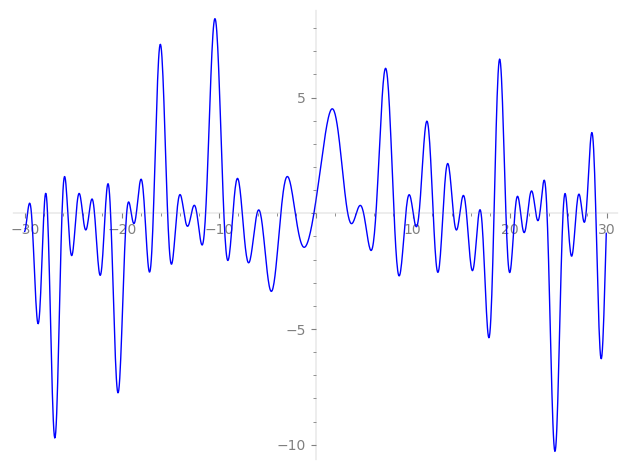| L(s) = 1 | + 1.68·2-s − 8.88i·3-s − 5.16·4-s + 0.217·5-s − 14.9i·6-s + (−7.49 + 16.9i)7-s − 22.1·8-s − 51.9·9-s + 0.367·10-s − 27.1i·11-s + 45.8i·12-s + 13.3i·13-s + (−12.6 + 28.5i)14-s − 1.93i·15-s + 3.94·16-s + 84.1·17-s + ⋯ |
| L(s) = 1 | + 0.595·2-s − 1.71i·3-s − 0.645·4-s + 0.0194·5-s − 1.01i·6-s + (−0.404 + 0.914i)7-s − 0.979·8-s − 1.92·9-s + 0.0116·10-s − 0.743i·11-s + 1.10i·12-s + 0.284i·13-s + (−0.241 + 0.544i)14-s − 0.0333i·15-s + 0.0615·16-s + 1.20·17-s + ⋯ |
\[\begin{aligned}\Lambda(s)=\mathstrut & 161 ^{s/2} \, \Gamma_{\C}(s) \, L(s)\cr =\mathstrut & (-0.802 - 0.596i)\, \overline{\Lambda}(4-s) \end{aligned}\]
\[\begin{aligned}\Lambda(s)=\mathstrut & 161 ^{s/2} \, \Gamma_{\C}(s+3/2) \, L(s)\cr =\mathstrut & (-0.802 - 0.596i)\, \overline{\Lambda}(1-s) \end{aligned}\]
Particular Values
| \(L(2)\) |
\(\approx\) |
\(0.155211 + 0.469103i\) |
| \(L(\frac12)\) |
\(\approx\) |
\(0.155211 + 0.469103i\) |
| \(L(\frac{5}{2})\) |
|
not available |
| \(L(1)\) |
|
not available |
\(L(s) = \displaystyle \prod_{p} F_p(p^{-s})^{-1} \)
| $p$ | $F_p(T)$ |
|---|
| bad | 7 | \( 1 + (7.49 - 16.9i)T \) |
| 23 | \( 1 + (24.3 - 107. i)T \) |
| good | 2 | \( 1 - 1.68T + 8T^{2} \) |
| 3 | \( 1 + 8.88iT - 27T^{2} \) |
| 5 | \( 1 - 0.217T + 125T^{2} \) |
| 11 | \( 1 + 27.1iT - 1.33e3T^{2} \) |
| 13 | \( 1 - 13.3iT - 2.19e3T^{2} \) |
| 17 | \( 1 - 84.1T + 4.91e3T^{2} \) |
| 19 | \( 1 + 126.T + 6.85e3T^{2} \) |
| 29 | \( 1 + 187.T + 2.43e4T^{2} \) |
| 31 | \( 1 + 163. iT - 2.97e4T^{2} \) |
| 37 | \( 1 + 347. iT - 5.06e4T^{2} \) |
| 41 | \( 1 + 395. iT - 6.89e4T^{2} \) |
| 43 | \( 1 - 340. iT - 7.95e4T^{2} \) |
| 47 | \( 1 + 200. iT - 1.03e5T^{2} \) |
| 53 | \( 1 - 40.1iT - 1.48e5T^{2} \) |
| 59 | \( 1 + 216. iT - 2.05e5T^{2} \) |
| 61 | \( 1 + 909.T + 2.26e5T^{2} \) |
| 67 | \( 1 - 383. iT - 3.00e5T^{2} \) |
| 71 | \( 1 - 688.T + 3.57e5T^{2} \) |
| 73 | \( 1 - 145. iT - 3.89e5T^{2} \) |
| 79 | \( 1 + 150. iT - 4.93e5T^{2} \) |
| 83 | \( 1 - 613.T + 5.71e5T^{2} \) |
| 89 | \( 1 + 473.T + 7.04e5T^{2} \) |
| 97 | \( 1 - 541.T + 9.12e5T^{2} \) |
| show more | |
| show less | |
\(L(s) = \displaystyle\prod_p \ \prod_{j=1}^{2} (1 - \alpha_{j,p}\, p^{-s})^{-1}\)
Imaginary part of the first few zeros on the critical line
−12.25669337733239340215091510557, −11.35004037361029402120485003267, −9.471166756719970322255554217491, −8.533370730061242833051290396018, −7.57119543035527345389739822040, −6.04690009308790481226289410674, −5.70401758656422524277763838734, −3.59445213868948300149506034076, −2.10370318052873706616839054883, −0.18639413757463850669518006278,
3.30259039178005425939698486890, 4.18496686601830907367632042921, 4.93530458236498107767010608847, 6.20846367360647183740094100615, 8.072536397672193116550627819277, 9.286128226416395737303981190579, 10.04671813133624916609349528209, 10.65117779018289106415081376294, 12.11062738344847293655990624251, 13.11535380602705792055788471200

